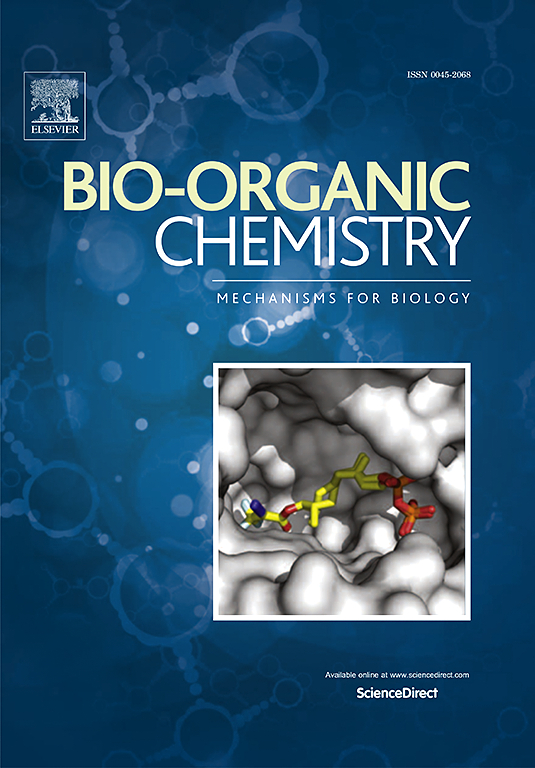设计和合成2,4-噻唑烷二酮取代1,3,5-三嗪衍生物,通过抑制逆转录酶以及抗sars CoV-2,抗菌和抗生物膜活性作为抗hiv药物
IF 4.5
2区 医学
Q1 BIOCHEMISTRY & MOLECULAR BIOLOGY
引用次数: 0
摘要
本研究展示了新型 1,2,4-噻唑烷二酮取代的 1,3,5-三嗪衍生物的设计与合成,这些衍生物可能是针对各种感染性疾病的抑制剂。标题类似物是通过多步工艺合成的,其结构通过元素分析和各种光谱分析(傅立叶变换红外光谱、1H NMR、13C NMR、质谱)得到了验证。根据与 HIV-1 RT 的分子对接和 MD 模拟实验,化合物 12a 在所开发的衍生物中具有较高的 CDdocker 作用能和稳定性,因此被确定为抗 HIV-1 的前导化合物。在基于细胞的实验中发现,化合物 12a 对 HIV-1 有效,它能阻止病毒在感染了 0.5 MOI HIV-1 NL4-1 的 CEM-GFP 细胞中复制。在使用无细胞 RT 法检测 HIV-1 RT 酶的 RNA 依赖性 DNA 聚合酶(RDDP)活性时,化合物 12a 的治疗指数为 113,EC50 为 125.1 nM。所有化合物都对 VeroE6-GFP 细胞系中的 SARS-CoV-2 复制有不同程度的抑制作用;尤其是化合物 10e、12e、12a、12b 和 12c 显示出相当强的抑制活性。在抗菌试验中,这些化合物对革兰氏阴性菌的抗菌作用强于革兰氏阳性菌,SAR 分析表明,三取代的 1,3,5-三嗪衍生物比二取代的衍生物具有更强的抑制活性。此外,在针对铜绿假单胞菌生物膜的测试中发现,12d 和 12e 是最有效的铜绿假单胞菌生物膜抑制剂。此外,还通过微型摇瓶法测试了活性最强的抑制剂 12a 和 12e 在 pH 值为 7.4 时的热力学溶解度。结果发现,羟基和吗啉的存在对它们的溶解度有显著影响。总之,我们的研究证明了 1,2,4-噻唑烷二酮取代的 1,3,5-三嗪衍生物对 HIV、SARS-CoV-2 和细菌微生物具有显著的抑制活性。本文章由计算机程序翻译,如有差异,请以英文原文为准。

Design, and synthesis of 2,4-thiazolidinedione substituted 1,3,5-triazine derivatives as anti-HIV agent via inhibition of reverse transcriptase along with anti-SARS CoV-2, antibacterial and antibiofilm activity
The present study demonstrated the design and synthesis of novel 1,2,4-thiazolidinedione substituted 1,3,5-triazine derivatives as putative inhibitors against various infective diseases. The title analogues were synthesized in a multi-step process, and their structures were verified through elemental analysis and a variety of spectral analyses (FT-IR, 1H NMR, 13C NMR, mass). Compounds 12a was identified as prospective lead compound against HIV-1 based on their high CDdocker interaction energy and stability among the developed derivatives, according to molecular docking and MD simulation experiments with HIV-1 RT. Compound 12a was found effective against HIV-1 in a cell-based experiment, preventing the virus from replicating in CEM-GFP cells infected with 0.5 MOI of HIV-1 NL4-1. In the RNA-dependent DNA polymerase (RDDP) activity of the HIV-1 RT enzyme using a cell free based RT assay, compound 12a showed a therapeutic index of 113 and an EC50 of 125.1 nM. All of the compounds inhibited SARS-CoV-2 replication in the VeroE6-GFP cell line to varying degrees; compound 10e, 12e, 12a, 12b, and 12c, in particular, showed considerable inhibitory activity. The compounds exhibited stronger antibacterial action against Gram-negative than Gram-positive bacteria in an antimicrobial assay, and a SAR analysis revealed that tri-substituted 1,3,5-triazine derivatives exhibited greater inhibitory activity than di-substituted ones. Additionally, 12d and 12e were found to be the most effective inhibitors of P. aeruginosa biofilms when tested against this bacterium. The most active inhibitors, 12a and 12e, were also tested for thermodynamic solubility at pH 7.4 via miniaturized shake-flask method. Here, their solubility was found to be significantly influenced by the presence of hydroxyl group and morpholine. In conclusion, our research demonstrated the significant inhibitory activity of 1,2,4-thiazolidinedione substituted 1,3,5-triazine derivatives against HIV, SARS-CoV-2, and bacterial microorganisms.
求助全文
通过发布文献求助,成功后即可免费获取论文全文。
去求助
来源期刊

Bioorganic Chemistry
生物-生化与分子生物学
CiteScore
9.70
自引率
3.90%
发文量
679
审稿时长
31 days
期刊介绍:
Bioorganic Chemistry publishes research that addresses biological questions at the molecular level, using organic chemistry and principles of physical organic chemistry. The scope of the journal covers a range of topics at the organic chemistry-biology interface, including: enzyme catalysis, biotransformation and enzyme inhibition; nucleic acids chemistry; medicinal chemistry; natural product chemistry, natural product synthesis and natural product biosynthesis; antimicrobial agents; lipid and peptide chemistry; biophysical chemistry; biological probes; bio-orthogonal chemistry and biomimetic chemistry.
For manuscripts dealing with synthetic bioactive compounds, the Journal requires that the molecular target of the compounds described must be known, and must be demonstrated experimentally in the manuscript. For studies involving natural products, if the molecular target is unknown, some data beyond simple cell-based toxicity studies to provide insight into the mechanism of action is required. Studies supported by molecular docking are welcome, but must be supported by experimental data. The Journal does not consider manuscripts that are purely theoretical or computational in nature.
The Journal publishes regular articles, short communications and reviews. Reviews are normally invited by Editors or Editorial Board members. Authors of unsolicited reviews should first contact an Editor or Editorial Board member to determine whether the proposed article is within the scope of the Journal.
 求助内容:
求助内容: 应助结果提醒方式:
应助结果提醒方式:


